Tech
The gig workers fighting back against the algorithms
Published
2 years agoon
By
Drew Simpson
In the Bendungan Hilir neighborhood, just a stone’s throw from Jakarta’s glitzy central business district, a long row of makeshift wooden stalls crammed onto the sidewalk serves noodle soup, fried rice, and cigarettes to locals.
One place stands out in particular, buzzing with motorcycle drivers clad in green. It’s an informal “base camp,” or meeting point, for drivers with Gojek, Indonesia’s largest ride-hailing firm—part of the backbone of a growing movement of resistance against the dispatch algorithms that dominate their lives.
Gojek offers motorbike taxis in addition to cars. You can see its trademark green jackets and helmets everywhere as its motorbike drivers take passengers on their back seats, and deliver food and parcels. In between gigs, drivers need to recharge their phones, eat food, and wash up. Since the company doesn’t offer many resting facilities, the community created its own spaces like this one in Bendungan Hilir, colloquially known as Benhil.
Regulars of this location prefer it for its proximity to many of the restaurants popular with Gojek’s food delivery customers. They can rest while staying “on-bid,” the local term for being available to take incoming orders—which is crucial because they must maintain that status for hours.
Base camps grew out of a tradition that existed before algorithmic ride-hailing services came to Indonesia. Motorcycle drivers used to offer rides to people informally, and they would gather at street corners and food stalls to trade news and gossip or share tips for staying safe on the road. Once Gojek and other apps arrived, the habit carried over, says Rida Qadri, an MIT computational social scientist who studies Jakarta’s ride-hailing driver communities. Base camps became the network through which drivers around the city stayed in tight communication.
This sense of community is now at the heart of what distinguishes Jakarta’s drivers from other gig workers around the world. While such workers everywhere have felt increasingly squeezed and exploited by unforgiving algorithms, most have struggled to organize and effect concrete changes in the platforms that control their work or the government policies that enable their mistreatment.
Part of this is due to the direct challenge that algorithmic management poses to labor organizers: it pits workers against one another and scatters them across a vast geographical area, says Jason Jackson, a political economy and urban planning professor at MIT who advised Qadri’s research. By default, it weakens workers’ abilities to connect in person and build the rapport needed to mobilize a movement.
This effect can be seen in the US especially, where Uber drivers haven’t been able to gain an audience with company leadership, let alone generate the momentum to fight against the company’s sophisticated anti-regulation strategies, says Veena Dubal, a law professor at the University of California Hastings College of the Law, who studies and advocates on behalf of US gig workers. “The digital formation of community just isn’t the same,” she says.
To support MIT Technology Review’s journalism, please consider becoming a subscriber.
But in Jakarta, things have played out differently. Through base camps, drivers don’t just keep each other informed; they support one another and band together to bend Gojek’s system a little more toward their will. It’s opened up new channels of communication with the company and laid the groundwork for lasting policy change.
Over the years, as more and more workers have fallen under the gaze of algorithms, a growing chorus of experts have noted how platform companies have paralleled the practices of colonial empires in using management tools to surveil and exploit a broad base of cheap labor. But the experience of Jakarta’s drivers could reveal a new playbook for resistance: a way for workers to build collective power, achieve a measure of security, and take care of one another when seemingly no one else will.
The greater Jakarta area is home to more than 30 million people. It’s a vast urban agglomeration that began developing at hyper speed in the 1970s and ’80s. Its main streets are lined with high-rises, malls, and five-star hotels. But a block away, tiny tin-roofed houses form cramped neighborhoods and winding alleys too narrow for cars.
Navigating this city has always been a challenge. Jakarta only opened its first modern metro line in 2019. Daily commutes consist of hours-long rides in cars and buses through gridlocked traffic or old-fashioned trains that pack passengers like sardines.
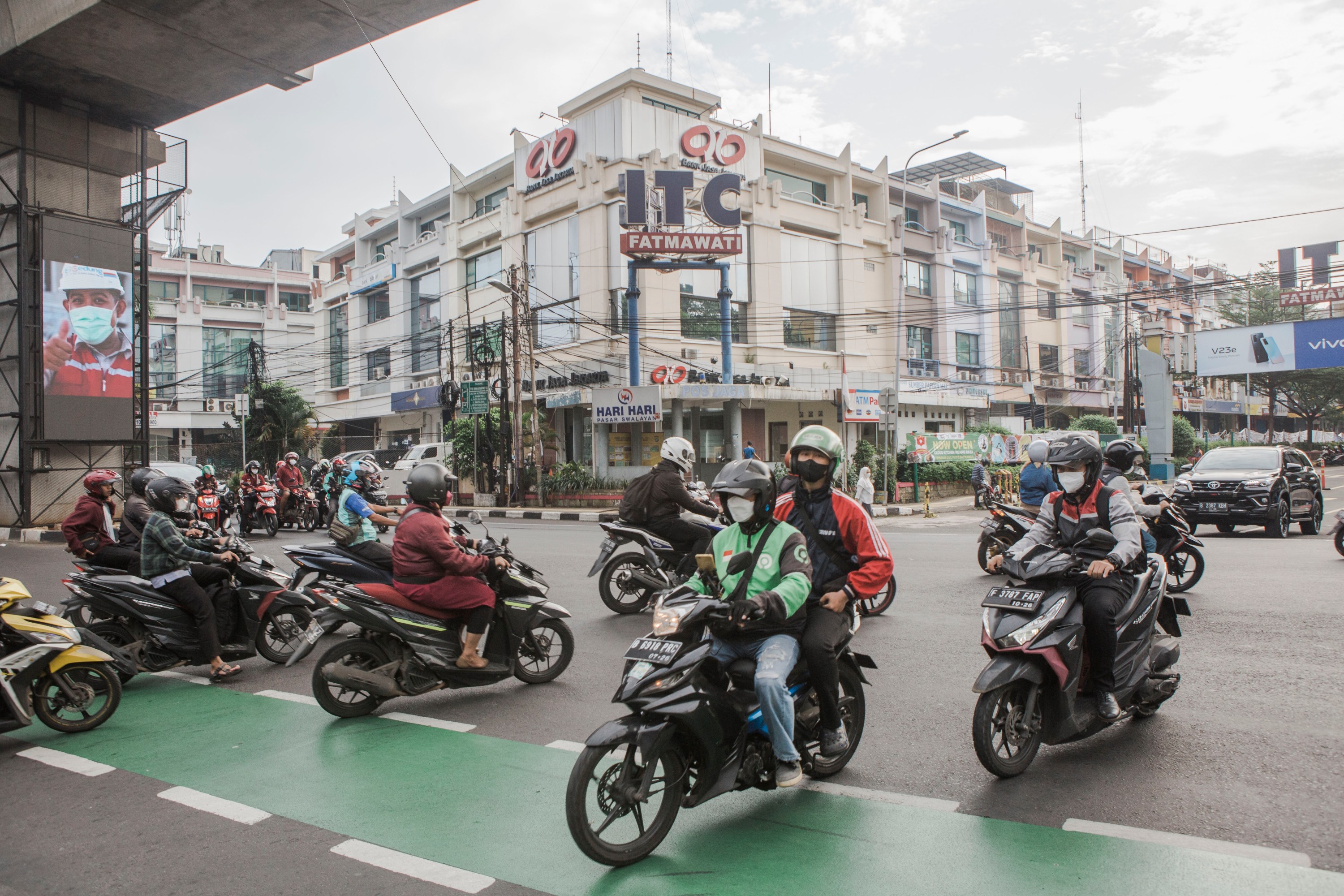
It was this sheer impossibility of getting around, especially during rush hour, that gave rise to an informal motorcycle taxi economy long before the advent of apps like Gojek. In this unregulated market, drivers (mostly men) with ojeks, the Indonesian word for motorbike taxis, waited on street corners across the city and offered people a lift when they’d run out of options.
For customers, the experience could be frustrating. Drivers organized in groups around different territories, largely based on their own neighborhoods, and sometimes declined to drive long distances. In a crowded commuter area like a train station, it could be stressful to wade through the crush of ojek drivers waving and shouting to get your attention, and to haggle for a price.
It was in this chaos that Gojek founder Nadiem Makarim saw a business opportunity. In 2010, Makarim, who’d grown up in a relatively privileged Indonesian family, established a call center to match passengers with trusted motorcycle drivers. For the first time, ojeks were being organized and dispatched by a third party. A year later, he expanded the idea when he joined the e-commerce startup Zalora, letting the company’s last-mile motorcycle delivery fleet ferry individuals around in their downtime.
Then Uber, with its novel algorithmic matchmaking system, entered Indonesia in August 2014. Gojek followed with its own mobile app a few months later, centralizing its existing fleet and consolidating the fractured neighborhood model under a unified set of algorithms.
Ordering ojeks via app, for a predetermined price, was a hit among passengers. It was catnip for investors as well, says Hian Goh, a partner at Singapore-based Openspace Ventures, one of Gojek’s earliest funders. Not only was Uber’s business model growing like crazy—a testament to Gojek’s explosive potential—but Makarim had the perfect founder profile for international investors in Indonesia’s underdeveloped tech scene. After years of elite schooling in Jakarta, he’d gone to an Ivy League college and Harvard Business School before taking a job at the top-tier management consulting firm McKinsey.
As more investor money poured in, there was little concern that Gojek would face any of the labor issues beginning to confront Uber. In the US, Uber had turned taxi driving from a salaried job with benefits into piecemeal gig labor. But in Indonesia, Gojek was turning informal transportation into an orderly, semi-formal industry. In the context of the rest of Indonesia’s largely informal economy, which encompassed everything from pop-up food stalls to unlicensed enterprises offering laundry or home cleaning, the government saw the change as a good thing.
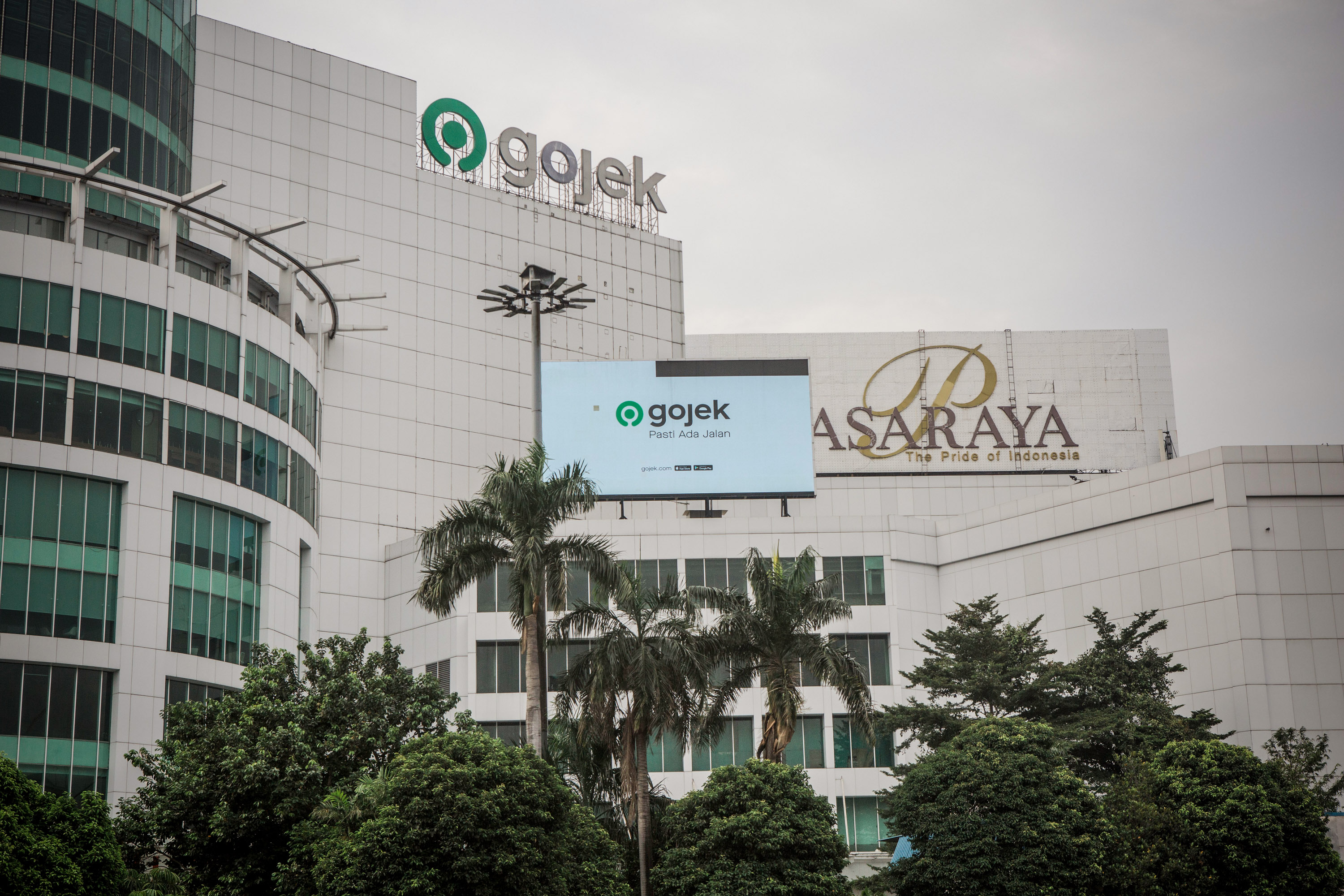
At first, drivers did too. Those who signed up with the intention of driving part time were soon quitting their jobs and converting to Gojek full time. Ojek drivers who held onto old forms of organization were squeezed out as the company bought out their colleagues with hefty bonuses and promises of earnings as much as triple their existing income.
But in exchange for the early gains, workers lost a significant amount of their agency. Where ojek drivers previously had a say in their pay and working conditions, there was now only obedience to the platform’s policies and its all-seeing algorithm.
Soon Gojek’s newly minted fleet began to feel the impact of this reality. As the company onboarded more and more drivers, jobs dwindled and prices dropped with excessive supply. Then as it entered into relentless price wars with its Singaporean competitor Grab, it reduced drivers’ bonuses, forcing them to work longer hours for the same money.
“When I interview representatives of the driver community, they say that their life in Gojek is like a drug addiction,” says Suci Lestari Yuana, a PhD candidate at Utrecht University, who studies the conflicts and controversies surrounding the platform economy in Indonesia. They watch their income shrink, but “they don’t have other options to get out anymore,” Yuana says. “They understand that they’re very dependent on the company.”
“Our driver partners are the core of our business, and their welfare will always be our top priority,” says Tanah Sullivan, head of sustainability at GoTo Group, Gojek’s parent company. “With the majority driving part-time, the flexibility Gojek offers allows drivers to augment their income with other earning opportunities… Based on our own data, both two-wheel and four-wheel drivers’ overall satisfaction has continued to improve particularly in relation to earnings on our platform.”
Kejo, in his 30s and father to two young girls, pulls up to the Benhil base camp on his Honda scooter around 7 p.m. Like many drivers, he sports the logo of his driver community, Gojek on Twit, or GoT, an informal collective he helped form in 2017 that stays connected through base camps and online groups.
Today his work day, which usually starts in the early afternoon, ended with an unexpected long-distance ride. It was tiring, but now he’s satisfied that he hit his daily target. He almost always hits his target, he says with a grin as he digs into a plate of fried rice. He admits he’s among the lucky ones. His account is considered gacor—a term that implies it’s inexplicably blessed with a steady stream of fresh orders.
Kejo (who, like many Indonesians, has only one name) joined Gojek in 2015, right when the app exploded in popularity. Though three-quarters of Indonesia’s employed perform informal work, according to the OECD, he hadn’t been among them; as a car salesman and a bank teller, he’d held stable jobs with benefits. But when Uber, Grab, and then Gojek came onto the scene, ride-hailing had a certain allure. It promised greater freedom than an office job—and, crucially, more money.
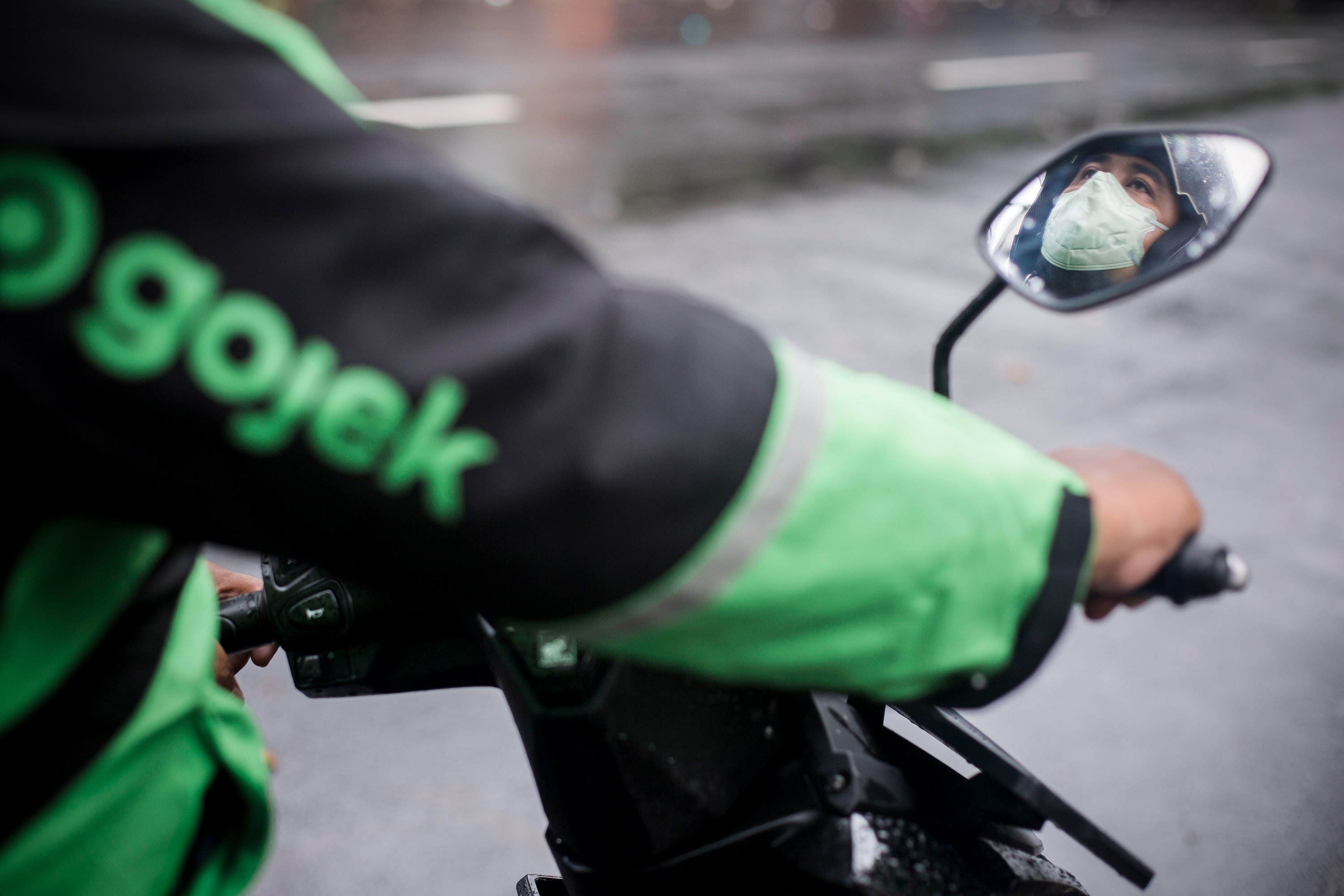
Indeed, he could earn 700,000 to 800,000 Indonesian rupiah (roughly $48 to $56) per day through 2016, when Gojek rewarded the most active “driver-partners” with generous bonuses. That could translate into an income that was significantly higher than the minimum wage in Jakarta, which is 4.6 million IDR, or $320, per month.
These days he instead makes 300,000 IDR ($21) at most, if he works from 2 p.m. to 7 or 8. Over time, Gojek phased out its bonuses as its driver network increased and it faced growing competition.
Kejo shrugs. He doesn’t let this bother him, but that doesn’t mean it’s been easy. Small incidents like delivering a package to the wrong door can lead a driver’s account to be frozen or closed, if the driver isn’t proactive in explaining what happened or solving the problem. The algorithm also penalizes workers for being inactive, even if they’re sick with covid. This demotes their account status and costs them access to more regular jobs.
“It really gives workers no option other than to keep working,” says Amalinda Savirani, an associate professor at Gadjah Mada University, who studies social movements among the urban poor in Indonesia. “The technology has become an instrument for this labor exploitation.”
“We have a number of measures in place that directly improve working conditions and provide opportunities for advancement of drivers, including education and training, health insurance, sick pay, and wellbeing initiatives,” Sullivan says. “These are in addition to comprehensive programs introduced to support driver partners across our ecosystem amid the challenges brought about by the pandemic.”
Kejo finds support in GoT. It evolved organically around a handful of people like him, who’d joined ride-hailing early and wrote about their experiences on social media.
Kejo’s specialty is identifying scams and warning drivers about them. Some drivers, new to using smartphones, can make easy targets: for example, sometimes fraudsters call, pretending to be Gojek employees, and steal login details and personal information. He uses his network to track new scams and their prevalence, and broadcasts them on his personal Twitter account, which has over 17,000 followers.
Any Gojek driver with a social media account can choose to participate, says Liam, another early GoT member. If one person shares a tip or a concern, it quickly travels through a loose network of WhatsApp and Telegram groups and across social media.
GoT also assists with “everyday problems on the road,” says Budi Prakoso, who connected with the group as a regular at the Benhil base camp. Once when his motorbike broke down, he immediately broadcast it to the group, and a nearby member arrived to help him out.
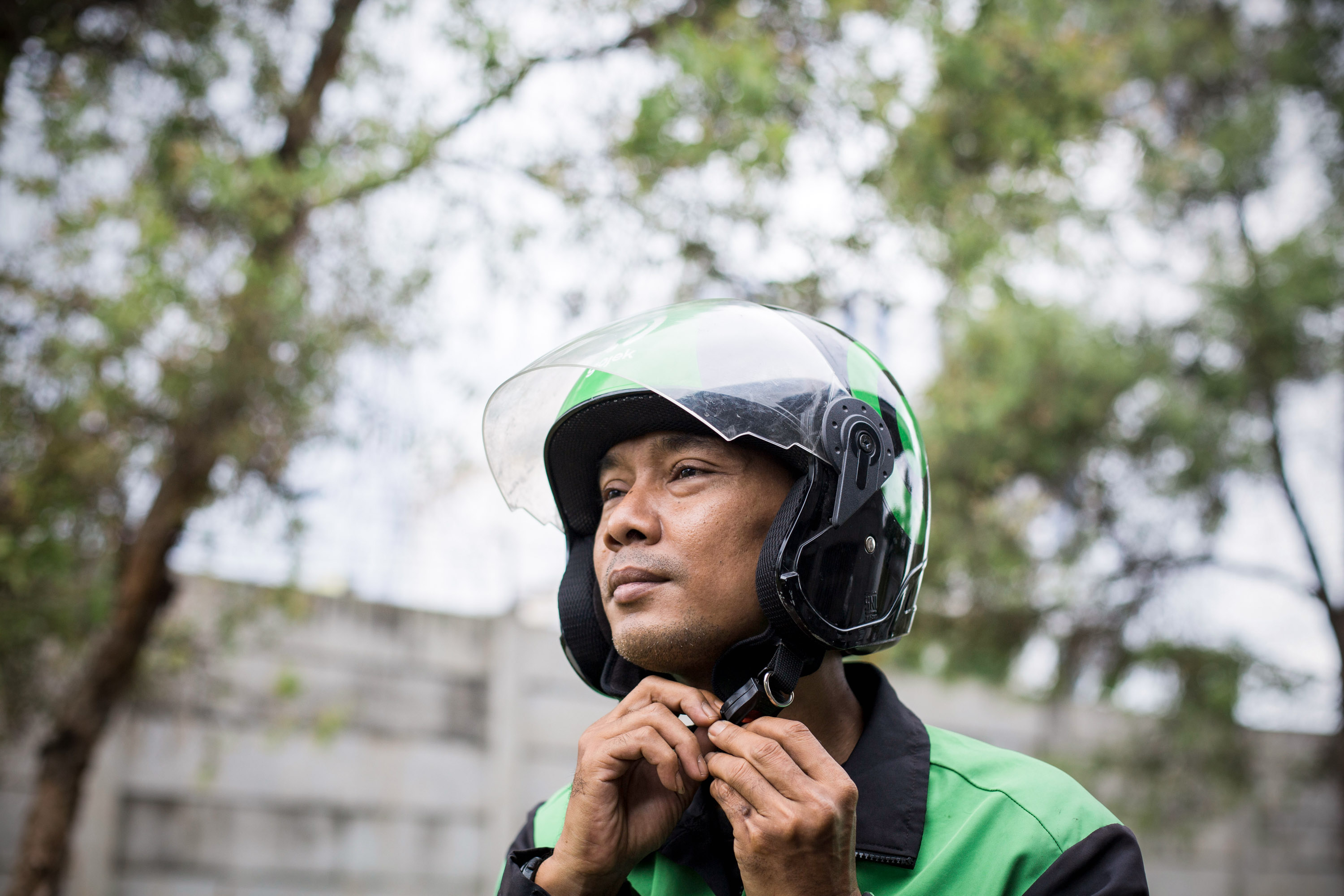
Qadri says there are hundreds of driver communities like GoT that have emerged from the base camps in Jakarta. Drivers will check in with each other daily for everything from advice on the best routes for a delivery to strategies for improving their earnings. During the pandemic, they distributed funds and food boxes to each other’s families, helping them weather otherwise devastating income disruptions from temporary ride-hailing bans and strict lockdowns.
For female drivers, who are a minority on the platforms, informal communities are also a way to stay safe. Rita Sari, who drives for Gojek’s four-wheel service GoCar, broadcasts her live location to GoT whenever she takes a ride to an unfamiliar neighborhood, especially at night. It doesn’t matter that GoT’s members are mostly drivers for Gojek’s motorbike-based services. Their solidarity extends beyond that peer group and even to drivers from rival firms like Grab.
Support comes from the broader community as well. Base camps form and sustain themselves through relationships between drivers and the neighborhood: business owners provide spaces, local authorities approve their use for regular gatherings, food stalls and mosques double up as makeshift shelters for young men without local family or housing who’ve moved to Jakarta to increase their Gojek earnings.
In this way, the many layers of social connections are crucial to helping drivers survive, Qadri says. And it was atop this foundation that the resistance first started.
It began with drivers converging on little hacks to make their daily work a bit easier. As more and more peers confronted the same frustrations, they spread their tricks through the networks like any other piece of information. Over time, those tricks matured into what Savirani describes as “everyday resistance”—tactics that helped drivers, absent any institutional support, to regain control in tiny, cumulative ways.
Kejo prefers a strategy known as “account therapy,” a way to coax Gojek’s algorithm when it isn’t supplying enough of the desired orders. He used to have an account that gave him mostly food deliveries but found it too difficult to keep up during the rainy season. Having observed that the Gojek app learns drivers’ preferences by keeping track of which jobs they accept, he began repeatedly rejecting food orders and accepting only passenger rides. After he persisted through a week of days without any work, the system finally “got it,” he says.
Other drivers who are skilled in deciphering the mysteries of the algorithm offer paid “therapy services” to those who are struggling. A therapist will take over a client’s phone for a week and slowly coax the account back to health before returning it to its owner.
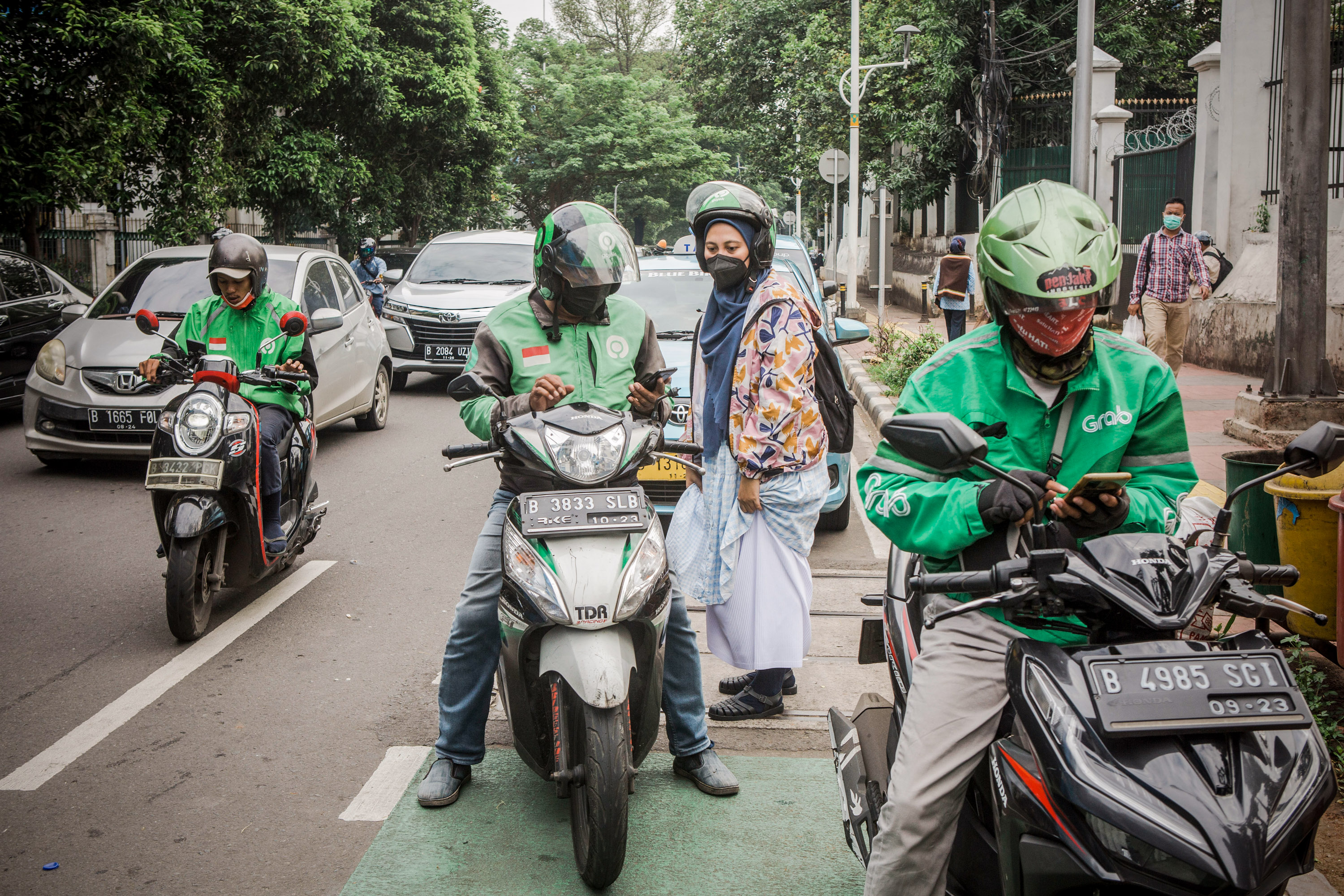
Then there are more sophisticated hacks. The more tech-savvy in the driver communities have developed an entire ecosystem of unauthorized apps that help drivers tweak and tune their accounts, Qadri says. Some are relatively trivial, built simply to eliminate a reliance on Gojek’s engineering team: they enlarge the text on the app’s user interface to improve its readability, or help drivers accept jobs automatically, a feature Gojek has by now incorporated.
But the most popular, with more than half a million downloads, spoof a phone’s GPS. They can give the illusion that a driver who is resting is still working. This can avoid penalties for sick time or help quickly graduate an account to higher levels with more earning potential. Such apps can also give drivers access to places with high customer demand without requiring them to muscle into crowded spaces.
All of these apps are known as tuyul, after a mythological creature in Indonesian folklore that steals money on behalf of its owner (though sometimes at a great price). If Gojek catches a driver using a tuyul, it suspends the account. This has led to an app war, Savirani says: developers build increasingly complex features to hide from Gojek’s detection systems as Gojek develops increasingly complex trackers to find them.
As driver networks have grown and accumulated political capital, they’ve also sought to agitate for broader reforms. They use social media to protest undesirable app updates or push for feature requests. Gojek now sends representatives to base camps to seek feedback and buy-in from drivers about forthcoming changes.
Just recently, GoT pushed through what Budi considers a breakthrough. Drivers often have to pay parking fees out of their own pocket if they pick up a food order. But after they campaigned against the policy, Gojek is now passing the fee on to customers at select mall and office locations. It’s also added an internal reporting mechanism that lets drivers earn a little extra income for sending updates about which malls charge parking fees and how much, Budi says.
“Drivers feel much more empowered, through their community structure, to reach out to management and negotiate with them in a way that I haven’t seen among Uber and Lyft drivers in the US,” Qadri says.
It’s not just management but regulators as well. When Jakarta was preparing to host the Asian Games in 2018, Garda, another motorbike taxi drivers’ association, threatened a strike that would have disrupted the flow of transportation to and from the sporting events. The prospect of such humiliation for Indonesia on the world stage was pressure enough to get the Ministry of Transportation to meet with the drivers.
As a result, the ministry finally recognized motorbike taxis, which had previously lacked legal status. That will pave the way for regulation to improve their working conditions, Yuana says.
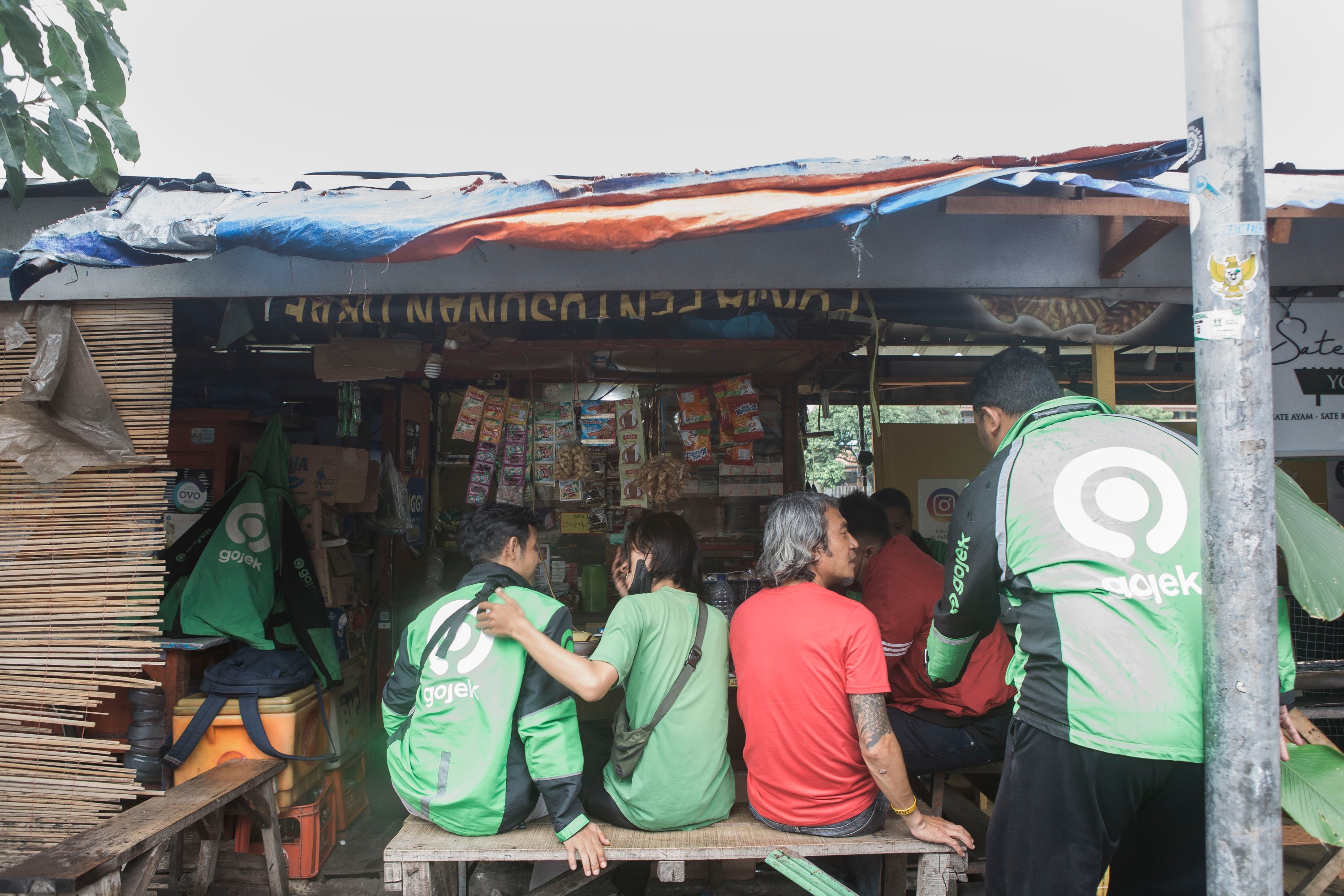
Dubal says these successes offer an important lesson to labor rights advocates outside of Indonesia: that a strong social infrastructure can be a powerful antidote to technical fragmentation. “You don’t get the kind of regulations you want without worker power, and you don’t have worker power without worker community,” she says.
That doesn’t mean the fight is over. Far from it: motorbike drivers, and app-based transportation services as a whole, are still largely unprotected by the law in Indonesia, says Taha Syarafil, the chairman of the drivers’ association Asosiasi Driver Online. And relying on everyday resistance and mutual aid to improve conditions without proper legal rights won’t be tenable forever.
Day by day, Gojek has tightened its controls on unauthorized apps and more severely cracked down on infractions. The company has also begun to buy the allegiance of some leaders in driver communities through tactics such as giving them early access to new features and awarding them side jobs.
But emboldened by their initial wins, drivers—especially those part of formal organizations like Asosiasi Driver Online—are now planning to push for more regulatory changes. This includes passing a law to recognize gig work at the highest level of government, which would enable the Ministries of Transportation and Labor to enforce minimum standards for ride-hailing companies’ treatment of drivers.
Even if that happens, though, informal communities will continue to play a role in easing whatever challenges come with the job—distributing food aid, helping with flat tires, raising money for a hospitalized friend. “The solidarity is strong,” Liam says. “Very, very strong.”
You may like
-


Eric Schmidt has a 6-point plan for fighting election misinformation
-


The Download: what’s next for AI, and fighting digital censorship
-


The Download: China’s monkeypox crisis, and fighting AI photo manipulation
-


We are all AI’s free data workers
-


The Download: inaccurate welfare algorithms, and training AI for free
-


The Benefits of Standing Desks for Office Workers
Tech
The hunter-gatherer groups at the heart of a microbiome gold rush
Published
4 months agoon
12/19/2023By
Drew Simpson
The first step to finding out is to catalogue what microbes we might have lost. To get as close to ancient microbiomes as possible, microbiologists have begun studying multiple Indigenous groups. Two have received the most attention: the Yanomami of the Amazon rainforest and the Hadza, in northern Tanzania.
Researchers have made some startling discoveries already. A study by Sonnenburg and his colleagues, published in July, found that the gut microbiomes of the Hadza appear to include bugs that aren’t seen elsewhere—around 20% of the microbe genomes identified had not been recorded in a global catalogue of over 200,000 such genomes. The researchers found 8.4 million protein families in the guts of the 167 Hadza people they studied. Over half of them had not previously been identified in the human gut.
Plenty of other studies published in the last decade or so have helped build a picture of how the diets and lifestyles of hunter-gatherer societies influence the microbiome, and scientists have speculated on what this means for those living in more industrialized societies. But these revelations have come at a price.
A changing way of life
The Hadza people hunt wild animals and forage for fruit and honey. “We still live the ancient way of life, with arrows and old knives,” says Mangola, who works with the Olanakwe Community Fund to support education and economic projects for the Hadza. Hunters seek out food in the bush, which might include baboons, vervet monkeys, guinea fowl, kudu, porcupines, or dik-dik. Gatherers collect fruits, vegetables, and honey.
Mangola, who has met with multiple scientists over the years and participated in many research projects, has witnessed firsthand the impact of such research on his community. Much of it has been positive. But not all researchers act thoughtfully and ethically, he says, and some have exploited or harmed the community.
One enduring problem, says Mangola, is that scientists have tended to come and study the Hadza without properly explaining their research or their results. They arrive from Europe or the US, accompanied by guides, and collect feces, blood, hair, and other biological samples. Often, the people giving up these samples don’t know what they will be used for, says Mangola. Scientists get their results and publish them without returning to share them. “You tell the world [what you’ve discovered]—why can’t you come back to Tanzania to tell the Hadza?” asks Mangola. “It would bring meaning and excitement to the community,” he says.
Some scientists have talked about the Hadza as if they were living fossils, says Alyssa Crittenden, a nutritional anthropologist and biologist at the University of Nevada in Las Vegas, who has been studying and working with the Hadza for the last two decades.
The Hadza have been described as being “locked in time,” she adds, but characterizations like that don’t reflect reality. She has made many trips to Tanzania and seen for herself how life has changed. Tourists flock to the region. Roads have been built. Charities have helped the Hadza secure land rights. Mangola went abroad for his education: he has a law degree and a master’s from the Indigenous Peoples Law and Policy program at the University of Arizona.
Tech
The Download: a microbiome gold rush, and Eric Schmidt’s election misinformation plan
Published
4 months agoon
12/18/2023By
Drew Simpson
Over the last couple of decades, scientists have come to realize just how important the microbes that crawl all over us are to our health. But some believe our microbiomes are in crisis—casualties of an increasingly sanitized way of life. Disturbances in the collections of microbes we host have been associated with a whole host of diseases, ranging from arthritis to Alzheimer’s.
Some might not be completely gone, though. Scientists believe many might still be hiding inside the intestines of people who don’t live in the polluted, processed environment that most of the rest of us share. They’ve been studying the feces of people like the Yanomami, an Indigenous group in the Amazon, who appear to still have some of the microbes that other people have lost.
But there is a major catch: we don’t know whether those in hunter-gatherer societies really do have “healthier” microbiomes—and if they do, whether the benefits could be shared with others. At the same time, members of the communities being studied are concerned about the risk of what’s called biopiracy—taking natural resources from poorer countries for the benefit of wealthier ones. Read the full story.
—Jessica Hamzelou
Eric Schmidt has a 6-point plan for fighting election misinformation
—by Eric Schmidt, formerly the CEO of Google, and current cofounder of philanthropic initiative Schmidt Futures
The coming year will be one of seismic political shifts. Over 4 billion people will head to the polls in countries including the United States, Taiwan, India, and Indonesia, making 2024 the biggest election year in history.
Tech
Navigating a shifting customer-engagement landscape with generative AI
Published
4 months agoon
12/18/2023By
Drew Simpson
A strategic imperative
Generative AI’s ability to harness customer data in a highly sophisticated manner means enterprises are accelerating plans to invest in and leverage the technology’s capabilities. In a study titled “The Future of Enterprise Data & AI,” Corinium Intelligence and WNS Triange surveyed 100 global C-suite leaders and decision-makers specializing in AI, analytics, and data. Seventy-six percent of the respondents said that their organizations are already using or planning to use generative AI.
According to McKinsey, while generative AI will affect most business functions, “four of them will likely account for 75% of the total annual value it can deliver.” Among these are marketing and sales and customer operations. Yet, despite the technology’s benefits, many leaders are unsure about the right approach to take and mindful of the risks associated with large investments.
Mapping out a generative AI pathway
One of the first challenges organizations need to overcome is senior leadership alignment. “You need the necessary strategy; you need the ability to have the necessary buy-in of people,” says Ayer. “You need to make sure that you’ve got the right use case and business case for each one of them.” In other words, a clearly defined roadmap and precise business objectives are as crucial as understanding whether a process is amenable to the use of generative AI.
The implementation of a generative AI strategy can take time. According to Ayer, business leaders should maintain a realistic perspective on the duration required for formulating a strategy, conduct necessary training across various teams and functions, and identify the areas of value addition. And for any generative AI deployment to work seamlessly, the right data ecosystems must be in place.
Ayer cites WNS Triange’s collaboration with an insurer to create a claims process by leveraging generative AI. Thanks to the new technology, the insurer can immediately assess the severity of a vehicle’s damage from an accident and make a claims recommendation based on the unstructured data provided by the client. “Because this can be immediately assessed by a surveyor and they can reach a recommendation quickly, this instantly improves the insurer’s ability to satisfy their policyholders and reduce the claims processing time,” Ayer explains.
All that, however, would not be possible without data on past claims history, repair costs, transaction data, and other necessary data sets to extract clear value from generative AI analysis. “Be very clear about data sufficiency. Don’t jump into a program where eventually you realize you don’t have the necessary data,” Ayer says.
The benefits of third-party experience
Enterprises are increasingly aware that they must embrace generative AI, but knowing where to begin is another thing. “You start off wanting to make sure you don’t repeat mistakes other people have made,” says Ayer. An external provider can help organizations avoid those mistakes and leverage best practices and frameworks for testing and defining explainability and benchmarks for return on investment (ROI).
Using pre-built solutions by external partners can expedite time to market and increase a generative AI program’s value. These solutions can harness pre-built industry-specific generative AI platforms to accelerate deployment. “Generative AI programs can be extremely complicated,” Ayer points out. “There are a lot of infrastructure requirements, touch points with customers, and internal regulations. Organizations will also have to consider using pre-built solutions to accelerate speed to value. Third-party service providers bring the expertise of having an integrated approach to all these elements.”
